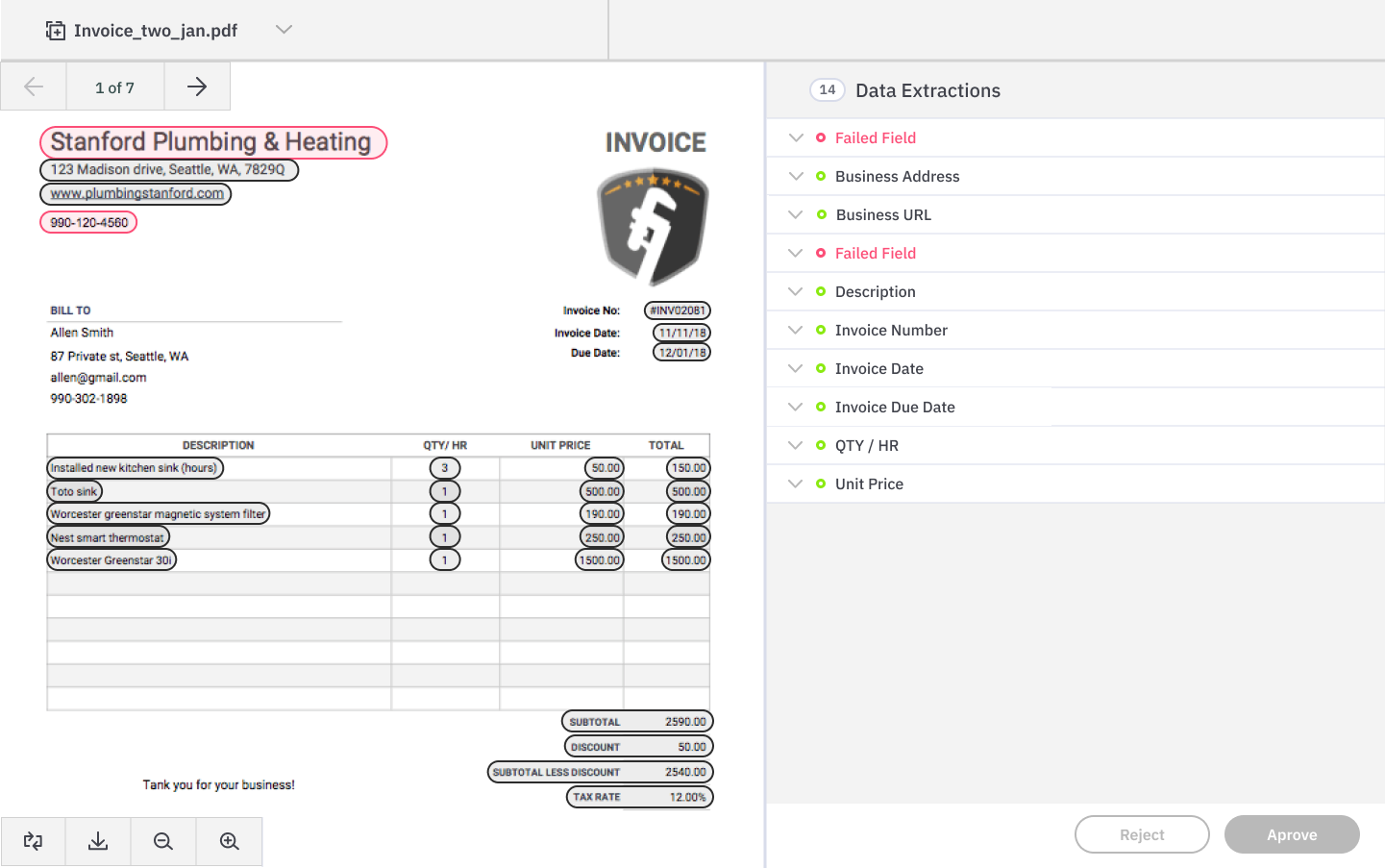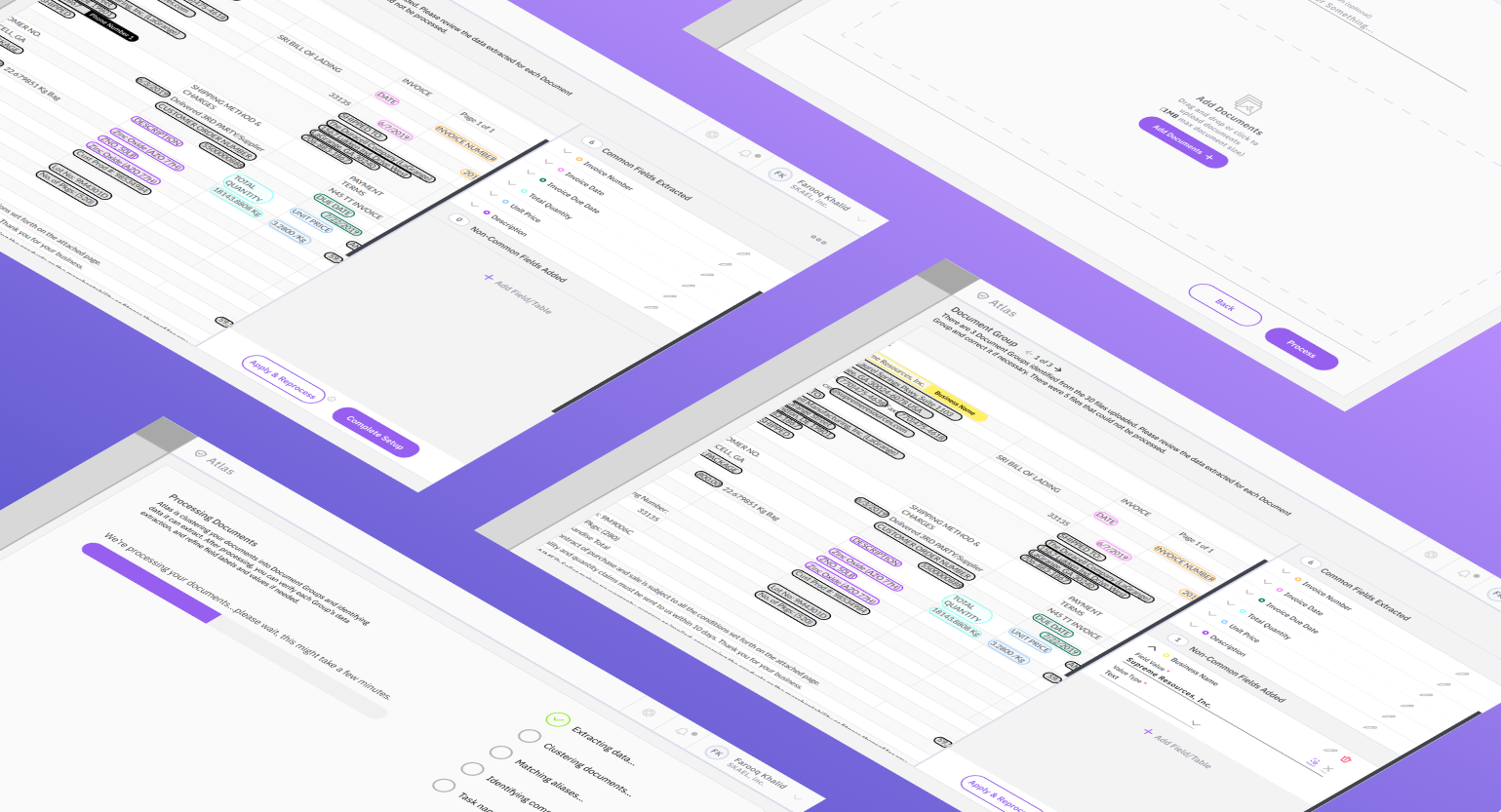PageAI — Designing an Intelligent Document Processor for Automation
.png)
1. Overview
When I joined SKAEL, my first major project as Lead Product Designer was to bring intelligence and simplicity to one of the most tedious business processes — document handling. PageAI is an Intelligent Document Processor (IDP) that extracts data from files like invoices, PDFs, images, and spreadsheets, and seamlessly integrates with SKAEL’s automation platform.
The vision was clear: empower non-technical users to automate document-heavy workflows with confidence and speed while giving SKAEL a stronger competitive edge in the automation space.
From Core to Control
V1 – Building the Core
Our initial focus was invoices, the most common and high-value use case. We wanted to help customers process hundreds of invoices at once without manual data entry or technical setup.
V1.1 – Evolving with Feedback
Once V1 went live, we noticed users needed more control during the Document Validation phase, especially when PageAI failed to recognize certain data fields. The goal of V1.1 was to make manual corrections faster and more intuitive, while maintaining the overall automation flow.
Leading with Versatility
My Role: Lead Product Designer
I led the end-to-end design, defining constraints, conducting competitive research, mapping user flows, wireframing, creating high-fidelity mockups, and iterating based on real customer feedback.
Team Composition:
• 1 Product Designer (me)
• 1 Product Manager
• 10+ Engineers (Front-End & Back-End)
A Pillar for Growth
PageAI wasn’t just another feature, it was a strategic pillar in SKAEL’s vision to scale automation.
• It gave non-technical users the power to process documents effortlessly.
• It expanded the automation platform’s capabilities with new use cases like invoice processing and validation checks.
• It directly improved productivity for enterprise clients, while positioning SKAEL as a stronger competitor to IDP (Intelligent Document Processor) leaders like UiPath, Automation Anywhere, and Vic.ai.
In short, PageAI made automation more human, accessible, and efficient.
From Insight to Interface
Competitive Research
To define what “great” looked like, I collaborated with our Product Manager to study leading IDP products such as IQBot (Automation Anywhere), UiPath Data Extraction, and Vic.ai.
Our research focused on:
- How these tools balanced accuracy, flexibility, and usability.
- The UX patterns that made them successful, and where they fell short.
- Opportunities to design something more intuitive and integrated for SKAEL users.
This research became the foundation for PageAI’s architecture and interaction model.
Mapping the Experience
We outlined three key user flows:
- General IDP Flow — a high-level blueprint of how users interact with any document processor.
- PageAI Setup Flow — how users configure extraction rules, data models, and document types.
- Run-Time Flow — how PageAI integrates with SKAEL’s automation platform during execution.
These flows helped the entire team: product, engineering, and QA to stay aligned on user touchpoints and system dependencies before any design work began.
Wireframes
I created mid-fidelity wireframes to visualize how users would upload documents, review extracted data, and validate results. The goal was to spark early discussions about technical feasibility and interaction patterns.
During these sessions, we identified layout constraints, potential API dependencies, and time estimates, which helped the engineering team plan efficiently.
Designing PageAI V1
For the first release, we focused on clarity and speed.
I designed the interface to feel structured yet approachable, and showing key document data alongside extraction results in real time. The right-hand column displayed extracted fields, while the document viewer on the left allowed quick verification.
To keep development on track, we opted for mid-fidelity mockups so engineers could start building early while we refined details in parallel.
View Full PageAI V1 Design
The beta was showcased to major clients like San Diego Housing Commission and Asurion, receiving positive feedback for simplicity and potential scalability.
V1.1 Iterations — Refining the Validation Experience
After gathering customer feedback, we prioritized three key improvements:
- Reducing Clutter in Dense Documents
Users struggled when documents contained many fields, making the right column overwhelming.
Solution: Allow users to click directly on values within the document to auto-expand the corresponding field in the validation panel. - Manual Input for Unrecognized Data
When PageAI couldn’t extract certain values, users were stuck.
Solution: Introduced a “Type-in” feature, allowing users to manually enter missing data. The system now validates input types to prevent errors and improve model accuracy.
- Table Extraction Capability
Customers often requested support for invoices containing tables.
Solution: Collaborated with engineers to define the technical path for table-format recognition, aligning with the roadmap for advanced data extraction.
Shaping SKAEL’s Edge
Despite limited resources and startup constraints, PageAI launched successfully in beta, becoming a core differentiator in SKAEL’s product suite.
- Positive stakeholder and customer feedback: clients praised its ease of use and automation speed.
- Adoption by GTM teams: used in demos to attract new enterprise leads.
- Foundation for scalability: architecture and UI patterns are now reused across other automation modules.
In short, PageAI helped SKAEL shift from “automation platform” to intelligent workflow ecosystem.
Growth Through Constraint
Winning Moments
Shifted from Waterfall to Agile Collaboration
Partnered with PMs and tech leads to create more fluid communication, enabling faster iteration cycles.
Defined Clear Scopes and Constraints
Improved cross-functional alignment by translating design vision into actionable, technically feasible requirements.
Bridged Design and Technology
Learned to think like engineers, designing within machine learning and data extraction limits while still advocating for user clarity.
Lessons Learned
Big Picture Thinking Matters
Every design decision affects scalability and alignment across Product, Marketing, and GTM teams.
Empathy + System Thinking = Strong Design
Understanding both user goals and technical realities helped craft experiences that were usable and buildable.
Leading PageAI taught me how to balance innovation with practicality, and turning an abstract AI concept into something users could understand, trust, and rely on daily. It reminded me that in automation design, success isn’t just about accuracy — it’s about creating experiences that make complex systems feel effortless.

.png)






